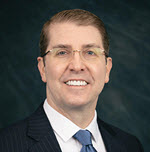A roundtable of experts discusses post-COVID supply chain issues

While personal protective equipment (PPE) is now in ample supply after the widespread disruptions during the pandemic, the healthcare industry still struggles with shortages in other categories. With this backdrop, HealthTrust CMO John Young, M.D., MBA, moderated a Becker’s Roundtable discussion in November—“Overcoming Obstacles to Achieve a Fully Integrated Supply Chain.” C-suite officers and attendees from more than two dozen integrated delivery networks (IDNs) shared insights on some of the most pressing topics facing them since the pandemic began. The biggest takeaway? Clinical integration remains of utmost importance when it comes to a healthy supply chain.
HealthTrust’s unique positioning
As Dr. Young explained to the attendees, HealthTrust has a unique view into the purchasing world, as one of the three largest group purchasing organizations (GPOs) nationally. These GPOs account for 90% of acute care hospital spend. HealthTrust’s membership includes 1,800 hospitals and over 100 health system members.
HealthTrust also leverages embedded operator experience, running the supply chain for HCA Healthcare as well as assisting with several other IDNs. This gives HealthTrust the same insider perspective that its other member hospitals and IDNs have. “We look at everything through a clinically integrated operational lens because we’re in the system too,” Dr. Young said. “We struggle with the same things you all struggle with, in terms of supply chain.”
Reducing waste & cost
Involving clinicians in supply chain decisions isn’t always easy. One participant shared that she recently interviewed an orthopedic candidate who said, “I don’t want to deal with any vendors, like for implants. I want someone else to deal with that.” She has found it challenging to gain physician involvement in supply chain issues.
Dr. Young shared that when he trained as an interventional cardiologist 15 years ago, he received no education on supply costs. Since then, having served in a number of corporate clinical leadership roles, he’s increasingly heard from physicians, especially service line leaders, who want to be more informed in this area. What captures their attention, he said, is price parity. They get frustrated if their system pays more than other health systems for the same items. “It’s a good motivator because they don’t like that, especially on the procedural side,” Dr. Young added.
Making changes to the supply chain, especially in implants and devices, is challenging. Doctors are comfortable with what they learn in training. Dr. Young related that it’s helpful to connect the physicians with peers outside of the organization to discuss their concerns and learn about what others are using.
Another way to involve physicians is by showing them how to reduce waste. Dr. Young shared that HealthTrust’s biggest impact with one IDN was quantifying the cost of excess osteobiologics, the compound used in lumbar and cervical fusions. Dr. Young’s team showed surgeons that they threw away large amounts of unused product during procedures. Multiplied over 16 hospitals in the IDN, that amounted to more than $1 million in annual waste. This type of analysis is a good place to start, he explained, as decreasing such waste doesn’t impact the physician’s clinical preference, and it starts to engage them in a broader cost conversation.
When a physician requests an expensive item, Dr. Young recommends that the supply chain team—sometimes with help from the CEO or CFO—explain how standardizing the use of equipment and supplies can lower overall costs, freeing up resources to pay for more expensive equipment. “The successes happen when we can deeply engage in one-on-one conversations with physicians,” Dr. Young said, along with aligning products and buying in scale to reduce clinical variation. “It’s easy on the commodity side, but with new, high-cost implants, the conversations are more challenging.”
Physicians might also become more interested in these concepts by joining a health system’s value analysis team. HealthTrust relies on nine Clinical Advisory Boards with roughly 25 members each, made up of service line leaders from GPO members in areas such as nursing, surgery and radiology. These boards recommend strategies to the overarching Supply Chain Board—the ultimate decision-makers—who almost always implement Clinical Advisory Board recommendations. HealthTrust’s Physician Advisor program includes about 125 practicing physicians, nationally representing all medical and surgical specialties, to help HealthTrust identify and navigate supply and change- management challenges such as product conversions.
Communication & mitigation strategies
The pandemic highlighted the need for better communication and transparency between suppliers, GPOs and health systems, especially when it comes to sharing assessments and mitigation plans as shortages arise. Health systems hear about shortages from other sources and must quickly determine how they may impact the care they deliver.
Recent problems with nuclear medicine agents, for example, are causing some health systems to cancel elective nuclear medicine imaging procedures—significantly impacting day-to-day patient care. In situations like this, Dr. Young added, HealthTrust is asked to not only share information, but to provide clinical conservation strategies. The pandemic ushered in an era of continuing shortages. One participant shared that his large health system changed its ad hoc shortage team to a permanent one, focusing on one shortage, then moving to another.
When negotiating contracts, HealthTrust includes contract language around transparency and supply chain resiliency strategies. While HealthTrust operates as a committed model—meaning that GPO members commit 80% of their spend to the HealthTrust contracted portfolio—the pandemic has presented some challenges. Dr. Young explained that the pandemic and subsequent supply chain shortages have driven the need for additional competitors and less reliance on sole-source contracting strategies. “The market has driven this change,” he added.
Formulary & IT issues
Dr. Young said his team continues to field requests from members looking to obtain knowledge from other providers. HealthTrust members are looking to lower their SKU numbers by relying on fewer suppliers and want to share best practices. “We’re building a knowledge service center for members to be able to see what other large systems are doing from a formulary perspective. They can also join a secure online community to share their challenges and learn how others have successfully overcome the same issues,” Dr. Young explained.
Data and information systems are increasingly important in the supply chain as well. “We are working on obtaining more robust data and the IT infrastructure to support the work,” Dr. Young added. One participant said his health system was starting to integrate physicians and IT staff into projects. That means including an IT staff member in all meetings and bringing them to conferences as well. This increases collaboration and ensures that the upstream and downstream IT impacts from any supply chain decisions are considered upfront. “Especially coming out of COVID, and from what I continue to see across the landscape, we have to be able to connect all of these dots to ensure a clinically integrated, resilient supply chain,” Dr. Young said.
BE A PART OF THE CONVERSATION and join the HealthTrust Huddle. Visit the Legacy Member Portal to access. You can network with peers, ask a clinical question or report a supply disruption issue. Contact the Clinical Services team for more information at clinical.services@healthtrustpg.com.
Share Email PPI, Q1 2023






